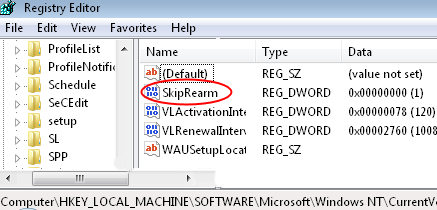Windows Vista Activation Hack
While I am happy to explain how SkipRearm postpones Vista’s activation, my recommendation is don’t try to cheat the Microsoft’s Licence agreement. My justification for publishing this Vista Activation Hack is that you cannot suppress knowledge. While this registry tweak walks the tightrope between the legal and software piracy, editing the SkipRearm value is not like cloning the product keys. Surprisingly, the source of this registry hack is a TechNet article on Microsoft’s own site.
Topics for Windows Vista Activation Hack
- Background to SkipRearm
- Limitations of SkipRearm
- Registry Instructions for SkipRearm
- Cheats Never Prosper
- Windows 8 SkipRearm
♦
Background to SkipRearm
The SkipRearm registry setting is designed to help large companies, who roll-out Vista with sysprep, or deploy other cloning software. The problem is that there could be a considerable delay – longer than 30 days – between installing Vista on the ‘Master’ machine and activating the clones. Nothing illegal here, just a big corporation installing lots of Vista machines over a period of several months.
Microsoft, kindly provide a mechanism for techies to re-arm the activation mechanism. You can legally run Vista’s built-in Software Licence manager to gain a 30 day extension of the grace period for activation. The command is slmgr -rearm.
Now here is the tricky bit, I would like to explain the relationship between the registry setting: SkipRearm and the command line: slmgr -rearm. Remember that the key is number 3. If the registry setting is SkipRearm = 0 then you get three goes at running slmgr -rearm. Next, let us check the logic of SkipRearm = 0, meaning count one of the 3 lives, and SkipRearm = 1, meaning don’t count one of those lives. In conclusion, changing the registry key to SkipRearm = 1, means don’t use up one of my three lives.
Since knowledge of the SkipRearm Vista activation hack has reached the public domain, unscrupulous end users, or even suppliers, could use this to delay activation. As a result anyone could install zillions of copies of Vista from just one legitimate product key. All you have to do is hack the registry and set SkipRearm = 1 before you run slmgr – rearm.
Limitations of SkipRearm
Research indicates that even using the SkipRearm registry hack, you can only use this technique 7 times to delay Windows Vista activation. Additionally, you can use slmgr.vbs -rearm three times, making 10 delays in all.
The knowledge that SkipRearm was designed to assist corporations with sysprep, helps us to understand why this registry hack will only work with these three versions of Vista: Enterprise, Business and Ultimate. However, I have heard rumours that it will also work with upgrade version of Vista Home.
Registry Instructions for SkipRearm
- Preliminary experiment, check the activation expiry date with the command: slmgr -xpr
- Launch Regedit. (See more details on starting regedit)
- Navigate to this path:
** HKLM\SOFTWARE \Microsoft\Windows NT\CurrentVersion\SL - Double-click SkipRearm and change the value to 1.
- Note: this registry hack does not make any sense on a machine which has already been activated!
- Now remember to run the 30 day extension command: slmgr -rearm
- Restart the machine. After it reboots, run slmgr -xpr and check the expiry date.
- Check the registry setting SkipRearm, slmgr resets the value to zero.
Screen Shot of SkipRearm

Guy Recommends: A Free Trial of the Network Performance Monitor (NPM) v11.5
v11.5
SolarWinds’ Orion performance monitor will help you discover what’s happening on your network. This utility will also guide you through troubleshooting; the dashboard will indicate whether the root cause is a broken link, faulty equipment or resource overload.
What I like best is the way NPM suggests solutions to network problems. Its also has the ability to monitor the health of individual VMware virtual machines. If you are interested in troubleshooting, and creating network maps, then I recommend that you try NPM now.
Download a free trial of Solarwinds’ Network Performance Monitor
Key Learning Points
- Do you find the SkipRearm value in HKCU** or HKLM?
Answer: HKLM - Should you create a value, or modify an existing setting?
Answer: Modify - Is SkipRearm a String Value or a DWORD?
Answer: DWORD - Do you need to Restart, or merely Logoff / On?
Answer: Restart. - Note: it is only worth trying this technique on a Vista Business, Enterprise or Ultimate machine that has not already been activated.
** HKLM is an abbreviation of HKEY_LOCAL_MACHINE, and HKCU is shorthand for HKEY_CURRENT_USER. These acronyms are so well-known that you can even use them in .reg files, Vista will understand and obey the registry instruction.
®
